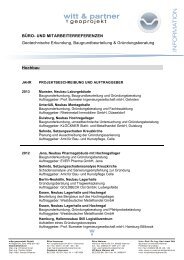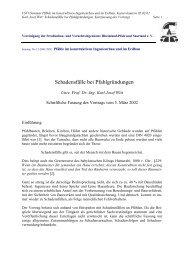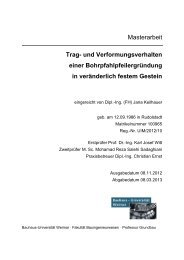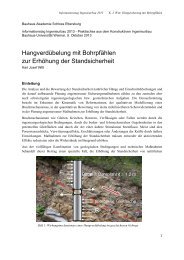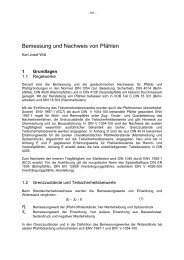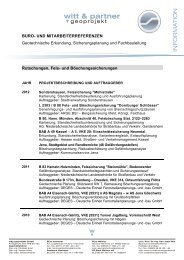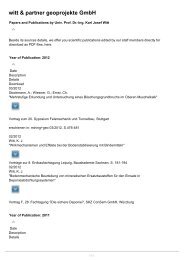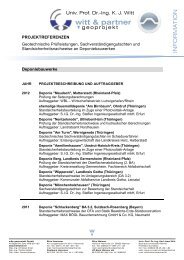A Static Analysis of Hydraulic Heave in Cohesive Soil - witt & partner ...
A Static Analysis of Hydraulic Heave in Cohesive Soil - witt & partner ...
A Static Analysis of Hydraulic Heave in Cohesive Soil - witt & partner ...
You also want an ePaper? Increase the reach of your titles
YUMPU automatically turns print PDFs into web optimized ePapers that Google loves.
<strong>in</strong>itiation <strong>of</strong> the crack will always be orthogonal to the<br />
direction <strong>of</strong> the smallest pr<strong>in</strong>ciple stress. In case <strong>of</strong> a<br />
start<strong>in</strong>g failure due to hydraulic heave this would be under<br />
consideration <strong>of</strong> soil decompression which leads f<strong>in</strong>ally to<br />
a lift<strong>in</strong>g <strong>of</strong> the bottom <strong>of</strong> the excavation. Accord<strong>in</strong>g to the<br />
documented results <strong>of</strong> the first experiments an <strong>in</strong>creas<strong>in</strong>g<br />
pore water pressure would force the expansion <strong>of</strong> the<br />
crack till the failure <strong>in</strong> form <strong>of</strong> hydraulic heave occurs.<br />
V. SUMMARY<br />
Aim <strong>of</strong> the present research is the exam<strong>in</strong>ation <strong>of</strong> the<br />
failure type, <strong>in</strong> detail liquefaction and wedge failure, due<br />
to hydraulic heave on a support<strong>in</strong>g wall <strong>of</strong> an excavation.<br />
The problem was analysed theoretically by comparison <strong>of</strong><br />
the critical hydraulic gradient <strong>in</strong> dependence <strong>of</strong> different<br />
erosion criteria, by computational calculations to validate<br />
the presented safety criteria <strong>of</strong> a wedge failure mechanism<br />
and by experiments to recognize the deformations pre and<br />
post failure.<br />
The <strong>in</strong>fluence <strong>of</strong> the cohesion on the failure process<br />
could be shown based on the comparison <strong>of</strong> different<br />
erosion criteria. To reach erosion <strong>in</strong> cohesive soils, i. e.<br />
structural collapse, a very high local hydraulic gradient<br />
would be necessary. This leads to the assumption that a<br />
wedge failure mechanism is valid even <strong>in</strong> low cohesive<br />
soils.<br />
The <strong>in</strong>troduced shapes <strong>of</strong> failure clods leads to the<br />
conclusion that the failure body on a sheet pile wall can be<br />
modelled as a parabolic clod <strong>in</strong> a first static<br />
approximation. The width <strong>of</strong> the mechanism depends<br />
significantly on the geological behaviour <strong>in</strong> the sphere <strong>of</strong><br />
<strong>in</strong>fluence. In this context layer<strong>in</strong>g and non isotropic<br />
permeability got the strongest <strong>in</strong>fluence on the shape. The<br />
presented formula to estimate the hydraulic potential<br />
difference at limit state can be used estimat<strong>in</strong>g the shape<br />
<strong>of</strong> the wedge. Generalis<strong>in</strong>g the thickness <strong>of</strong> the failure<br />
body will be half <strong>of</strong> the embedd<strong>in</strong>g, if isotropic conditions<br />
will be present. When us<strong>in</strong>g the formula to estimate the<br />
safety it is essential to realize that energy conversion<br />
while deformation and liquefaction <strong>of</strong> the soil as well as<br />
the horizontal fixation <strong>of</strong> the support<strong>in</strong>g are unconsidered.<br />
Summaris<strong>in</strong>g the first results <strong>of</strong> the study hydraulic<br />
heave <strong>in</strong> cohesive soils will arise as a wedge failure. Only<br />
soil with very small cohesion (ca. c’ ≤ 2,5 kN/m²) will fail<br />
<strong>in</strong> the manner described <strong>in</strong> the common formula by<br />
Terzaghi. The mechanism <strong>of</strong> failure <strong>in</strong> highly cohesive<br />
soils is dom<strong>in</strong>ated by the development <strong>of</strong> cracks. If they<br />
are already existent genetically failure will occur <strong>in</strong> a<br />
certa<strong>in</strong> type <strong>of</strong> uplift. The pr<strong>in</strong>ciple which leads to cracks<br />
due to pressure can be described by the phenomenon <strong>of</strong><br />
hydraulic fractur<strong>in</strong>g us<strong>in</strong>g an approach that considers the<br />
energy needed for deformation and the propagation <strong>of</strong><br />
cracks.<br />
ACKNOWLEDGEMENT<br />
The results presented <strong>in</strong> this contribution are part <strong>of</strong> an<br />
ongo<strong>in</strong>g research-work <strong>in</strong> the order <strong>of</strong> the German Federal<br />
Waterways Eng<strong>in</strong>eer<strong>in</strong>g and Research Institute – BAW.<br />
The fund<strong>in</strong>g assistance provided by the BAW <strong>in</strong> support<br />
<strong>of</strong> this project is gratefully acknowledged.<br />
REFERENCES<br />
[1] Z. Bažant, „Grundbruch unter e<strong>in</strong>er Spundwand“, „Bautechnik“<br />
(18), pp. 595 – 599, 1940<br />
[2] R. Davidenk<strong>of</strong>f, “Unterläufigkeit von Stauwerken,” Werner-<br />
Verlag GmbH, 1970.<br />
[3] R. Davidenk<strong>of</strong>f, „Anwendung von Filtern im Wasserbau“, Verlag<br />
Ernst & Sohn, 1976<br />
[4] W. Knaupe, „Aushub umschlossener Baugruben unter besonderer<br />
Berücksichtigung des hydraulischen Grundbruches im<br />
schichtweise gelagerten Baugrund“, Dissertation - Hochschule für<br />
Bauwesen Leipzig, 1972<br />
[5] H. Leuss<strong>in</strong>k, T. G. Visweswaraiya, H. Brendl<strong>in</strong>, „Beitrag zur<br />
Kenntnis der bodenphysikalischen Eigenschaften von<br />
Mischböden“, Veröff. Des Institutes für Bodenmechanik und<br />
Grundbau der Techn. Hochschule Fridericiana <strong>in</strong> Karlsruhe, 1964<br />
[6] B. Müllner, „Beitrag zur Untersuchung der Erosionssicherheit<br />
b<strong>in</strong>diger Mischböden bei vertikaler Durchströmung“, Mitt. des<br />
Fachgebietes Grundbau, Boden- und Felsmechanik<br />
Gesamthochschule Kassel – Universität, 1991<br />
[7] E. Rehfeld, „Die Erosionsbeständigkeit b<strong>in</strong>diger Lockergeste<strong>in</strong>e“,<br />
Wiss. Zeitschrift der TU Dresden, 5/67, pp. 1431 – 1437, 1967<br />
[8] K. Terzaghi, R. B. Peck, “<strong>Soil</strong> Mechanics <strong>in</strong> Eng<strong>in</strong>eer<strong>in</strong>g<br />
Practice,” John Wiley & Sons, 1. Corrected pr<strong>in</strong>t<strong>in</strong>g, 1968.<br />
[9] K. J. Witt, R.-B. Wudtke, „hydraulisch bed<strong>in</strong>gte Versagensformen<br />
<strong>in</strong> der Sohle von Baugruben“, BAW & Bauhaus-Universität<br />
Weimar, 2006<br />
[10] Y. Zou, „Der vom Spannungszustand und vom Bodengefüge<br />
abhängige Erosionsdurchbruch b<strong>in</strong>diger Böden“, Wasserwirtschaft<br />
(90), pp. 554 – 559, 2000



